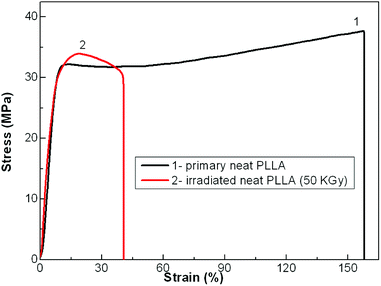Irradiation of poly(L-lactide) biopolymer reinforced with functionalized MWCNTs†
Ali Nabipour Chakoli*a,
Jinmei Heb,
Maryam Amirian Chayjanc,
Yudong Huang*b and
Baode Zhangd
aNuclear Safety and Radiological Protection Research Dep., NSTRI, P. O. Box: 14395-836, Tehran, Iran. E-mail: a_nssabipour@yahoo.com
bSchool of Chemical Engineering and Technology, State Key Laboratory of Urban Water Resource and Environment, Harbin Institute of Technology, Harbin 150001, China. E-mail: ydhuang.hit1@yahoo.com.cn; Fax: +86-451-8622-1048; Tel: +86-451-8641-4806
cTeachers University, Ferdosi Center, Baghestan, Karaj, Iran
dSchool of Mechanical Engineering, Liaoning Shihua University, Fushun, 113001, China
First published on 11th June 2015
Abstract
Radiation sterilization processes by high energy radiation are successfully utilized for modification and sterilization of sensitive biodegradable and biocompatible polymer composites. The effect of γ-irradiation on mechanical and thermal properties of poly (L-lactide) (PLLA) biodegradable polymer reinforced with PLLA grafted from multiwalled carbon nanotubes (MWCNT-g-PLLA)s was characterized. For this purpose, the PLLA chains covalently grafted from the sidewall of aminated MWCNTs. Then, the MWCNT-g-PLLAs/PLLA composite films are prepared by solution casting using chloroform as solvent. The prepared composites were γ-irradiated and characterized by differential scanning calorimeter (DSC), SEM and tensile test instruments. It is found that the γ-irradiation increases the tensile modulus and tensile strength, while decreases the elongation at break. The melting point of composites decreases by irradiation, while the melting enthalpy increases. Additionally, It is found that if the γ-irradiation of composites increases to higher than 50 kGy, the rigidity and brittleness of composites, that have more concentrations of functionalized MWCNTs, increase gradually.
1. Introduction
Reinforcing of biodegradable polymers such as poly(L-lactide) (PLLA) can be an approach to overcoming some limitations of single applications of these materials, such as brittleness, low stiffness, and low toughness.1–3 For this purpose, biodegradable polyesters are extensively studied as matrix materials in biocomposites reinforced with various nanomaterials for improving their performance.4–7 The multiwalled carbon nanotubes (MWCNT)s, which have been used as reinforcing fillers for reinforcing the polymeric biomaterials, will dramatically improve the material's mechanical strength.8,9 Application of bio polymeric nanocomposites in vivo requires appropriate functionalization to reduce toxicity and non-specific binding.10–12 Response of the organism to the implanted composite biomaterials depends on numerous factors. One of the most important characters for implanted composite biomaterials is sterility. Different procedures can be utilized for sterilization of sensitive polymers, such as sterilization by ethylene oxide gas, low temperature plasma, injection moulding, steam, dry heat, etc11,13. On the other hand, radiation and commercially dominated sterilization process by high energy radiation are successfully utilized for modification and sterilization of sensitive PLLA. The dominant effect of irradiation on PLLA is chain scissoring, but there are some recent reports concerning irradiation cross linking by introducing cross linking agent. However, because of excellent penetration characteristics of ionizing radiation, radiation sterilization eliminates problems which may appear with other sterilization methods. Especially in the case of complicate multi-component biomaterials with porous structure such as HAp/PLLA, sterilization by radiation may be a step more than necessary.14,15 The problems with radiation sterilization sometimes evolved as a result of the damaging effects of radiation on materials.Since high energy electromagnetic and particle radiation exhibit properties of controlled penetration and intensities, which are especially suitable for synthesis and modification of polymeric biomaterials without the need of usually toxic additives, the interest for performing radiation techniques in biotechnology and biomedicine is growing rapidly.16
Irradiation creates free radicals which will often chemically react in various ways, sometimes at slow reaction rates. The free radicals can recombine forming the cross-links. Another influence which may not be as subtle is oxidation during irradiation.
The possible radical that can be formed during γ-irradiation of PLLA is presented in Scheme 1, according to the literatures.16,17 The scheme shows that it is possible to create two radicals for each monomer of PLLA chains by γ-irradiation. Hence it is predictable that the irradiation of MWCNT-g-PLLAs/PLLA, creates some radicals not only on bulk PLLA chains but also on the grafted polymer chains on the sidewall of MWCNT-g-PLLAs. Due to the created radicals in composites, the covalent bonds can be created between grafted polymer chains and matrix polymer chains. As a result of the radiation effect, the polymers are subject in varying extents to degradation and cross-linking reactions. Parameters such as morphology, chemical structure of the polymer, dose and irradiation media determine whether cross-linking or chain scission is the dominating effect of the irradiation.
 | ||
| Scheme 1 The possible radical formation in PLLA polymer chains under the γ-irradiation.16,17 | ||
In this research, the PLLA chains were grafted on the surface of aminated MWCNTs. Then, the neat PLLA was reinforced using functionalized MWCNTs. The prepared composites were irradiated using 60Co irradiator. To investigate the effect of irradiation on the morphology of composites, the SEM has been carried out. The physical and mechanical properties of irradiated composites were characterized using DSC and tensile test device.
2. Experimental
2.1 Materials
Pristine MWCNTs (pMWCNTs) were purchased from Boyu Gaoke Co, Beijing, China. The diameter of MWCNTs is 10–20 nm, length is 10–30 μm and special surface area is higher than 200 m2 g−1. The p-amino benzoic acid, poly phosphoric acid and phosphorus penta oxide (P2O5) were purchased from Kermel of China as analytic reagent.The L-lactide oligomer (LA) (Xiaogan Esun New Material Co, China) is used as received. The stannous octanoate (St(Oct)2) (Shanghai chemical reagent company, China) is used as a catalyst for LA polymerization. The chloroform, ethanol, methanol, toluene were purchased from Kermel of China as analytic reagent.
2.2 Synthesis of aminated MWCNTs
Aromatic amines were introduced on the surface of the pMWCNTs using p-amino benzoic acid, poly phosphoric and P2O5. For this purpose, the p-amino benzoic acid, pMWCNTs and poly phosphoric acid were added into a three-neck round-bottom flask equipped with nitrogen inlet pipe, and mechanical stirrer. The reactants were mechanically stirred at 120 °C for 3 h under nitrogen atmosphere to form a homogenous mixture. Then, P2O5 was added to the mixture, and then the mixture was heated for 12 h. The reacted mixture was washed with distilled water and then vacuum-filtered through a 0.22 μm Millipore polycarbonate membrane. The filtered solid was dried in oven at 50 °C over night.18 The PLLA graft from the sidewall of MWCNTs (MWCNT-g-PLLAs) was synthesized using aminated MWCNTs using LA and Sn(Oct)2 as initiator. To remove the ungrafted PLLA chains and LA monomers, the synthesized material was dissolved in chloroform and vacuum-filtered through a 0.22 μm Millipore polycarbonate membrane four times. Then the product was dried in a vacuum oven at 40 °C for 2 days.182.3 Preparation of nanocomposites
The MWCNT-g-PLLAs was dissolved in chloroform and mixed with the solution of neat PLLA in chloroform to achieve MWCNT-g-PLLAs/PLLA composites having 0.5, 1.0, 2.0 and 3.0 wt% loading of MWCNT-g-PLLAs. The mixtures were left in glass molds three days at room temperature after stirring for chloroform evaporation, then the glass molds contains composite films were vacuum dried in an oven at 40 °C for 2 days to completely evaporation of chloroform. The films were removed from glass molds and cut for characterization. The neat PLLA homopolymer was prepared as introduced in our previous works.9,192.4 γ-Irradiation of composites
The neat PLLA and its composites were irradiated in a calibrated 60Co irradiator (Issledovatel type PX-30) with the activity of 4500 Ci and dose rate of 0.1 Gray per second (Gy s−1) in air atmosphere and at room temperature. For each kind of samples two different doses are directed, 5000 Gray (50 kGy) and 100![[thin space (1/6-em)]](https://www.rsc.org/images/entities/char_2009.gif) 000 Gray (100 kGy). After irradiation the samples were cut for test experiments.
000 Gray (100 kGy). After irradiation the samples were cut for test experiments.
2.5 Characterization
The SEM images refer to the MWCNTs and the fracture surfaces of composites were acquired using a Hitachi S-4700 field emission system. The fracture surface of tensile test samples after breaking was sputter coated with a thin layer (ca. 3 nm) of Au prior to SEM imaging.The differential scanning calorimetery (DSC) was carried out with a Perkin-Elmer Diamond DSC. The samples (10 ± 0.5 mg) were placed in aluminium crucibles. An empty aluminium crucible was used as reference. Samples were heated from −30 °C to 200 °C at flow of nitrogen. Heating rate of 20 °C min−1 was used and continuous recordings of the heat flow and sample temperature were taken. To enhance the accuracy of characterization test results, each sample considered as average of at least three specimens.
The tensile behaviour of neat PLLA and its composites with various concentrations of MWCNT-g-PLLAs are carried out according to the ASTM D638 standard method. The tensile tests are performed using a microcontroller electronic tension meter (model WDW3100) machine at a crosshead speed of 2.5 mm min−1 at room temperature. The value of tensile modulus, yield strength, ultimate strength, and elongation at break of each sample are the average of at least three specimens per sample.
3. Results and discussion
3.1 Morphology of primary and irradiated nanocomposites
Fig. 1(a) gives the surface morphology of synthesized MWCNT-g-PLLAs. The MWCNT-g-PLACLs have a diameter strongly more than that of pristine MWCNTs. The MWCNT-g-PLLAs were entangled together at the intersection points. This indicates that the grafting reaction took place over the whole surface of the MWCNTs. The grafted PLLA chains from the MWCNT can entangle with the grafted chains of neighbour MWCNT like brush hair.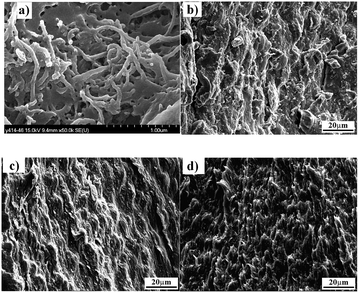 | ||
| Fig. 1 The SEM micrographs of MWCNT-g-PLACLs (a), the fracture surface refer to neat PLLA (b) and the fracture surface for composites: (1 wt%)MWCNT-g-PLLAs/PLLA (c) and (3 wt%)MWCNT-g-PLLAs/PLLA (d). | ||
Fig. 1(b) presents the fracture surface of neat PLLA after tensile test. It can be seen that the fracture surface of neat PLLA, due to the crystallinity of PLLA, is not very smooth. The breaking points are near to the crystalline phases of samples. Fig. 1(c) and (d) presents the fracture surface of (1 wt%)MWCNT-g-PLLAs/PLLA and (3 wt%)MWCNT-g-PLLAs/PLLA (d) composites, respectively, after tensile test at room temperature. At the fracture surface of the (1 wt%)MWCNT-g-PLLAs/PLLA, there is some wide tips that which maybe caused during elongation at fracture points. Additionally, there are many fine tips that can be attributed to the pulled out and fractured MWCNT-g-PLLAs under the tensile test.
At the fracture surface of the (3 wt%)MWCNT-g-PLLAs/PLLA composite, the MWCNT-g-PLLAs are well dispersed throughout the polymer matrix. The adhesion effect between MWCNTs and PLLA matrix is greatly improved because most of the MWCNT-g-PLLAs on the fracture surface are pulled out and then some of them broken. Therefore, the functionalization of MWCNTs effectively improves the dispersion and interfacial bonding in MWCNTs reinforced PLLA polymer composite.
During dispersion of small fillers in a low viscosity medium, diffusion processes and filler–filler and filler–matrix interactions play an increasingly important role as the diameter drops below one micrometer. Both of the size and specific surface area of MWCNT-g-PLLAs significantly influences the dispersion process. These regions are distinctly different from the bulk polymer and can represent a substantial volume fraction of the matrix for nanoparticles with surface areas of the order of hundreds of m2 g−1. The actual inter phase volume depends on the dispersion and distribution of the MWCNT-g-PLLAs particles, as well as their surface area.
The surface morphology of neat PLLA and its composites with various concentrations of MWCNT-g-PLLAs after 50 kGy γ-irradiation are indicated in Fig. 2. The SEM micrograph shows that the 50 kGy γ-irradiation slightly changes the surface morphology of composites. As can be seen, some defects were created on the surface of neat PLLA and its composites.
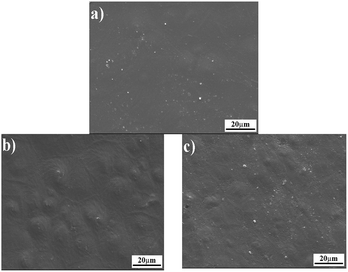 | ||
| Fig. 2 The SEM micrographs of neat PLLA (a) and its composites with various concentrations of MWCNT-g-PLLAs, 1 wt% (b) and 3 wt% (c) after 50 kGy γ-irradiation. | ||
The surface morphology of neat PLLA and its composites with various concentrations of MWCNT-g-PLLAs after 100 kGy γ-irradiation are presented in Fig. 3. It can be seen that the density of surface defects after 100 kGy γ-irradiation is significantly higher than that of 50 kGy γ-irradiated composites.
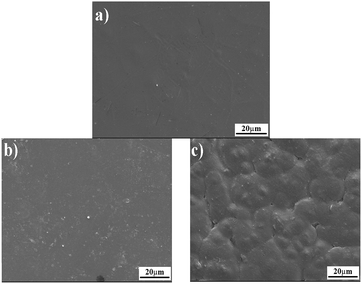 | ||
| Fig. 3 The SEM micrographs of neat PLLA (a) and its composites with various concentrations of MWCNT-g-PLLAs, 1 wt% (b) and 3 wt% (c) after 100 kGy γ-irradiation. | ||
It can be seen that the created defects in the lower concentration of amorphous phase in (3 wt%)MWCNT-g-PLLAs/PLLA composites, after 100 kGy γ-irradiation is higher than that of neat PLLA. The crystalline phase of composites and the spherulites, due to their rigidity, has higher strength in comparison with amorphous phase during the γ-irradiation.
3.2 Thermal properties of primary and irradiated composites
The DSC curves of neat PLLA before and after γ-irradiation under the air atmosphere at room temperature such as melting point and melting enthalpy are illuminated in ESI.†It can be seen that the melting point of neat PLLA decreases after γ-irradiation. The result indicates that the chain scissoring is occurred during γ-irradiation. Hence, the melting point of PLLA decreases due to molecular chain scissoring. As can be seen, the melting enthalpy of irradiated neat PLLA is slightly higher than that of primary neat PLLA. It reveals that the crystallinity of neat PLLA slightly increases during γ-irradiation. It may due to the cross-linking effect of γ-irradiation on PLLA molecular chains and creation of smaller lamellaes with shorter polymer chains that made of scissoring effect of γ-irradiation on PLLA.
Fig. 4 shows the DSC curves of neat PLLA and its composites with 1 wt% and 3 wt% of MWCNT-g-PLLAs after 50 kGy γ-irradiation.
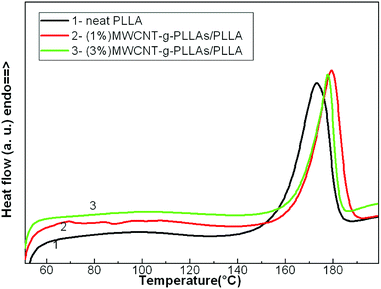 | ||
| Fig. 4 The DSC curves of neat PLLA and its composites with various concentrations of MWCNT-g-PLLAs after 50 kGy γ-irradiation under the air atmosphere at room temperature. | ||
The detailed information of Fig. 3 such as melting point and melting enthalpy of neat PLLA and MWCNT-g-PLLAs/PLLA after 50 kGy γ-irradiation are illuminated in Table 1. The results show that after γ-irradiation, the crystallinity of composites are higher than that of neat PLLA. The increment in crystallinity of irradiated MWCNT-g-PLLAs composites decreases with increasing the concentrations of MWCNTs-g-PLLAs. It is due to decreasing the mobility of polymer chains with increment the concentrations of MWCNT-g-PLLAs. Before irradiation, the crystallinity of MWCNT-g-PLLAs is increases with increasing the concentrations of MWCNT-g-PLLAs. Hence, the mobility of broken PLLA chains during γ-irradiation decreases.
| Filler contents (wt%) | Melting point (°C) | Melting enthalpy (J g−1) |
|---|---|---|
| 0 | 173.2 | 47.3 |
| 1 | 179.4 | 42.5 |
| 3 | 177.5 | 41.2 |
Fig. 5 shows the DSC curves of neat PLLA and its composites with 1 wt% and 3 wt% of MWCNT-g-PLLAs after 100 kGy γ-irradiation. The melting point and melting enthalpy of neat PLLA and its composites after 100 kGy γ-irradiation under the air atmosphere at room temperature are illuminated in Table 2. The results indicate that before and after γ-irradiation, the crystallinity of composites are higher than that of neat PLLA. The crystallinity of irradiated MWCNT-g-PLLAs composites decreases with increasing the concentrations of MWCNTs-g-PLLAs. It is due to decreasing the mobility of broken PLLA chains with increment in concentrations of MWCNT-g-PLLAs.
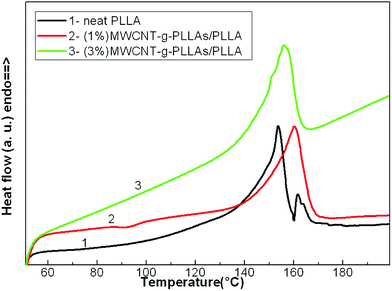 | ||
| Fig. 5 The DSC curves of neat PLLA and its composites with various concentrations of MWCNT-g-PLLAs after 100 kGy γ-irradiation under the air atmosphere at room temperature. | ||
| Filler contents (wt%) | Melting point (°C) | Melting enthalpy (J g−1) |
|---|---|---|
| 0 | 153.5 | 52.3 |
| 1 | 160.3 | 50.7 |
| 3 | 155.9 | 48.9 |
Before irradiation, the crystallinity of composites is increases with increasing the concentration of MWCNT-g-PLLAs. Hence, the mobility of broken PLLA chains during γ-irradiation decreases. The broken PLLA chains under γ-irradiation create small lamellaes. Increment in concentration of small lamellaes in composites decreases the melting point of composites. The results show that the melting enthalpy of composites decreases with increasing the concentrations of MWCNT-g-PLLAs in composites. Less movement of polymer chains that made of scissoring effect under the γ-irradiation in composites in comparison with the neat PLLA, occurs due to the MWCNT-g-PLLAs, that decreases the creation of new lamellaes after γ-irradiation.
3.3 Mechanical properties of primary and irradiated composites
The stress–strain curves of neat PLLA before and after γ-irradiation are presented in Fig. 6. The summary of tensile test results for neat PLLA, before and after 50 kGy γ-irradiation are indicated in Table 3.| MWCNT-g-PLLAs | Tensile modulus (MPa) | Yield strength (MPa) | Ultimate strength (MPa) | Elongation (%) |
|---|---|---|---|---|
| 0 (primary PLLA) | 4.1 | 32.3 | 37.8 | 158 |
| 0 (irradiated PLLA) | 3.6 | 29.5 | 30.1 | 40.55 |
| 0 | 3.6 | 29.5 | 30.1 | 40.55 |
| 1 | 4.86 | 33.2 | 35.8 | 16.4 |
| 3 | 5.5 | 38.7 | 40.5 | 13.9 |
The results show that after 50 kGy γ-irradiation of neat PLLA, the tensile modulus and yield strength increases, while, the elongation at break decreases 74%. In addition, the 100 kGy γ-irradiated neat PLLA, is too brittle to do tensile analysis. As can be seen, the γ-irradiation decreases the mechanical performance of neat PLLA. It means that the γ-irradiation for neat PLLA is not useful to enhance the performance of neat PLLA. It must be considered that for sterilization of devices that made of PLLA, the γ dose must be less than 50 kGy.
The stress–strain curves of neat PLLA and its composites with various concentrations of MWCNT-g-PLLAs, after 50 kGy γ-irradiation at room temperature are presented in Fig. 7.
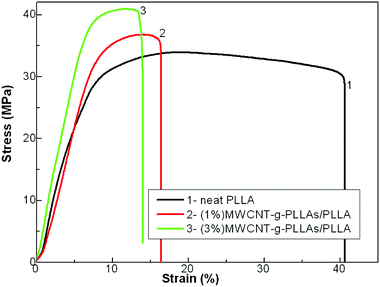 | ||
| Fig. 7 The tensile test results of 50 kGy γ-irradiated neat PLLA and its composites with various concentrations of MWCNT-g-PLLAs at room temperature. | ||
The summary of tensile test results are indicated in Table 3. Due to the decreasing in mobility of broken PLLA chains with increment the concentrations of MWCNT-g-PLLAs, the elongation at break of neat PLLA decreases. Before irradiation, the crystallinity of composites is increases with increasing the concentration of MWCNT-g-PLLAs. Hence, the mobility of broken PLLA chains during γ-irradiation decreases. The broken PLLA chains under γ-irradiation create small lamellaes. The ratio of crystalline phase in composites increases with increasing the concentrations of MWCNT-g-PLLAs in composites. Due to lower concentration of amorphous phase in (3 wt%)MWCNT-g-PLLAs/PLLA, the elongation at break decreases. In addition, the shorter PLLA chains occur low elongation at break under the tensile test. It can be seen that the γ-irradiation slightly increases the tensile strength of neat PLLA and its composites, while, decreases the elongation at break gradually. Rapid decreasing in mechanical properties occurs when higher irradiation doses (100 kGy) is imposed.
Decreasing in mechanical properties is considered to be correlated to degradation (chain scission) of neat PLLA under the γ-irradiation. Nevertheless, after γ-irradiation at 100 kGy, the pure PLLA film is clear and colorless, but it lost its mechanical strength. Hence, the 100 kGy irradiated samples are brittle and useless for tensile test and related analysis.
Conclusions
Effect of γ-irradiation on novel nanocomposites of poly(L-lactide) biopolymer reinforced with functionalized MWCNTs was characterized. For this purpose, the pristine MWCNTs were aminated without shortening of MWCNTs. Then, the PLLA polymer chains grafted from the surface of aminated MWCNTs. The composite of neat PLLA with various concentrations of MWCNTs were prepared for characterization and γ-irradiation. The results show that after 50 kGy γ-irradiation of PLLA nanocomposites, the tensile modulus and yield strength increases, while, the elongation at break decreases gradually. Additionally, if the γ-irradiation of composites increases to higher than 50 kGy, the rigidity and brittleness of composites, that have more concentration of functionalized MWCNTs, increase gradually. And finally, it will not be applicable for medical or other performance. Hence, it is necessary to consider that for sterilization of these kinds of composites the γ-irradiation must be lower than 50 kGy.Acknowledgements
This work was financially supported by “Tai Mountain Scholar” project from “We Go” group Co., Ltd and Shandong province government of China and supported from the Chang Jiang Scholars Program and the National Natural Science Foundation of China (no.51073047, no. 91016015).Notes and references
- X. Deng, J. Hao and C. Wang, Biomaterials, 2001, 22, 2867–2873 CrossRef CAS.
- Z. Hong, P. Zhang, C. He, X. Qiu, A. Liu, L. Chen, X. Chen and X. Jing, Biomaterials, 2005, 26, 6296–6304 CrossRef CAS PubMed.
- H. Tsuji and K. Suzuyoshi, Polym. Degrad. Stab., 2002, 75, 347–355 CrossRef CAS.
- Z. Qiu and W. Guan, RSC Adv., 2014, 4, 9463–9470 RSC.
- C. Chen, L. Chen, L. Cao, W. Shen, L. Yu and J. Ding, RSC Adv., 2014, 4, 8789–8798 RSC.
- N. Kasyapi and A. K. Bhowmick, RSC Adv., 2014, 4, 27439–27451 RSC.
- J. Zhou, Z. Jiang, Z. Wang, J. Zhang, J. Li, Y. Li, J. Zhang, P. Chen and Q. Gu, RSC Adv., 2013, 3, 18464–18473 RSC.
- D. Zhang, M. A. Kandadai, J. Cech, S. Roth and S. A. Curran, J. Phys. Chem. B, 2006, 110, 12910–12915 CrossRef CAS PubMed.
- J. Feng, W. Cai, J. Sui, Z. Li, J. Wan and A. N. Chakoli, Polymer, 2008, 49, 4989–4994 CrossRef CAS PubMed.
- F. Rozema, R. Bos, G. Boering, J. Van Asten, A. Nijenhuis and A. Pennings, J. Appl. Biomater., 1991, 2, 23–28 CrossRef CAS PubMed.
- D. Mohr, M. Wolff and T. Kissel, J. Controlled Release, 1999, 61, 203–217 CrossRef CAS.
- D. Depan, J. Shah and R. Misra, Polym. Degrad. Stab., 2013, 98, 2331–2339 CrossRef CAS PubMed.
- K.-H. Lee and C.-C. Chu, Google. Patents, 1996.
- E. Suljovrujić, N. Ignjatović and D. Uskoković, Radiat. Phys. Chem., 2003, 67, 375–379 CrossRef.
- E. Suljovrujić, N. Ignjatović, D. Uskoković, M. Mitrić, M. Mitrović and S. Tomić, Radiat. Phys. Chem., 2007, 76, 722–728 CrossRef PubMed.
- J. Loo, C. Ooi and F. Boey, Biomaterials, 2005, 26, 1359–1367 CrossRef CAS PubMed.
- H. Mitomo, A. Kaneda, T. M. Quynh, N. Nagasawa and F. Yoshii, Polymer, 2005, 46, 4695–4703 CrossRef CAS PubMed.
- A. N. Chakoli, J. He, W. Cheng and Y. Huang, RSC Adv., 2014, 4, 52372–52378 RSC.
- M. Amirian, A. N. Chakoli, J. H. Sui and W. Cai, Polym. Bull., 2013, 70, 2741–2754 CrossRef CAS.
Footnote |
| † Electronic supplementary information (ESI) available. See DOI: 10.1039/c5ra08319b |
| This journal is © The Royal Society of Chemistry 2015 |

